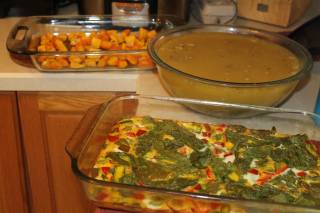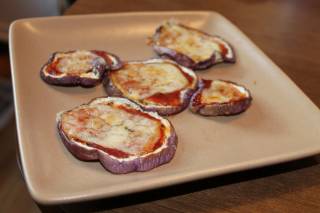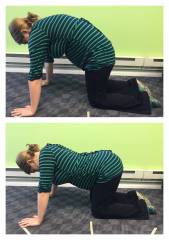One of the most common questions that I get is, how is it possible to actually eat only real, unprocessed foods, in the midst of the busyness of life? My response is that it takes preparation! It is very possible to eat real food without it feeling like it is taking over your life but it does take some time to figure out a routine that will work for you and your family and it definitely takes planning ahead.
My typical week involves grocery shopping once per week and two days (usually Saturday or Sunday and Wednesday) spent preparing food to have meals ready for the next 3 or so days for two people. That way, besides those concentrated times where I am in the kitchen, I do not feel like a slave to the kitchen the rest of the week or dread it being the end of the day and not knowing what we will have for dinner.

Here is what went down in that two hour cooking session this past weekend.
What I made:
What will this give us?
The egg casserole yields 6 healthy servings so this is our breakfast for 3 days. We will have 2-3 meals out of the soup for dinners or easy lunches packed in thermoses. The extra veggies and sausages will make out the rest of our meals and can be heated up simply as is or used in stir fry’s or curries to provide some variation but still quick meals.
What I did:
I begin by preheating the oven and prepping my veggies for the egg casserole. I toss this together and throw it in to bake at 350 for 40 minutes. While the egg casserole is cooking I get the soup going. I already had shredded chicken and broth from dinner the night before (a great thing to make in the crock pot the night before food prep to have on hand!) Instead of roasting the veggies like she suggests in the recipe link, I simply throw them in the stock pot with the broth and let them cook in there.
Now we have the egg casserole in the oven with about 15 minutes left and soup simmering on the stove. Next I prep veggies that I want for the week. On one baking sheet I did cubed butternut squash, on another other I roasted a mixture of broccoli, cauliflower, carrots and onions. The egg casserole timer dings and I take that out. Bump the temperature up to 425 to roast the vegetables and throw both pans of veggies in at 425 and set the timer for 30 minutes.
The egg casserole is done and cooling, the soup is simmering on the stove and the veggies are in the oven. All that’s left is the Italian sausages. I quickly mix the ingredients together for those and cook them on a cast iron pan. The sausages are finishing just as the veggies are beeping. The veggies aren’t quite done yet so I set the timer for five more minutes and take the sausages off of the pan. Next the veggies come out and begin cooling. This gives me a chance to get back to the simmering soup. Per the recipe, some of veggies in the soup are pureed while the others are left whole so I use a ladle to scoop a 4-5 ladles worth of soup into the blender and blend until pureed. I throw the puree back in with the rest of the soup and add the spinach until the spinach is wilted and everything is blended together.
OK! You did it! This is the final stage now that everything is cooked and just needs to be packaged up for easy meals. I slice the egg casserole into 6 pieces and place into separate containers for easy to heat up meals in the morning. I put the sausage in one container to simply grab and reheat as needed. I put the roasted veggies in a few containers depending on what I have on hand (sometimes individual containers are nice to be throw into quick lunches to go). The soup gets stored in a big glass bowl in the fridge for easy stove top reheating.
Whew! Did I mention that this was also a good workout? You are so close at this point, just the clean up remains. Maybe you can recruit a willing child or spouse to help you out with this part but in my experience, it’s best to just tackle it right away to get that full feeling of accomplishment, instead of letting it wait for later and get harder to clean.
Now you can relax in knowing that you have several nutritious meals packaged up and ready to go for the next few days! Now you can get a few extra minutes of precious sleep in the morning and you will certainly avoid the fast food line at dinner!
Article by: Joelle Kurczodyna, NTP
While this is an article for those of us who are or are thinking about becoming pregnant, it is also important for EVERYONE to read! Most people suffer from some sort of skin condition over the course of their life. This could be anything from acne, to dry skin, to rashes, to psoriasis.
If you watch the news or commercials, you probably think that the only way to combat these problems is with the latest and greatest cream, lotion, steroid, antibiotic, or miracle product. This could not be further from the truth!!! Our skin is a reflection of what is going on under the surface in our bodies.
If we have been eating an inflammatory diet (processed foods, refined sugars etc), this will likely lead to skin reactions! Remember, these inflammatory foods include many items often touted as “Healthy” such as skim milk, low fat yogurt, granola bars, and pretzels. Food is the only fuel that our cells have- and the skin is made of layers of cells! If we aren’t nourishing our bodies with good food, our skin cells are going to reflect that! As they say- you are what you eat! If you need a reminder of what these “good foods” are- check out the first article in the series here!
 Growing Belly- Still stretch mark free at 38 weeks!
Growing Belly- Still stretch mark free at 38 weeks!
My Top Rule of Skin Care- If I wouldn’t put it in my mouth, I won’t put it on my skin! Just like when I am in the grocery store, I READ THE LABELS. If a product is made of all sorts of processed chemical ingredients that I can’t pronounce or wouldn’t eat, why would I want to absorb them through my approximately 35 billion skin cells!
One of my favorite quote’s about skin care come from the book “Skintervention” by Liz Wolfe NTP. “Beauty starts from the inside and good nutrition is absolutely critical to healthy skin. Anyone who tells you differently, or claims you can beautify or heal your skin or body without good nutrition is absolutely wrong- and probably trying to sell you a product line.”
Stretch marks-
Stretch marks occur when the body is growing faster than the skin can keep up with. Clearly this is happening with a rapidly expanding belly during pregnancy, but is there anything you can do about it? Many studies have shown that belly creams, salves, and balms do not cause a reduction in stretch marks! While many sources say that it is all about having good genes and good luck, I truly believe there are things that you can do to improve the elasticity of your skin. These involve giving it the proper nutrients that it needs to repair and stretch quickly.
Which foods in particular would do this? Foods that are high in collagen (bone broth!), foods high in vitamins A, C, and E, and having a balanced omega 3 to 6 ratio! So what should you be eating? Homemade soups! Gelatin! Nutrient dense good sources of proteins, fats (especially fish for the omega 3s), and lots of multi colored vegetables! Remember, just because you are taking a prenatal vitamin, doesn’t mean that you are off the hook in terms of getting your body and your baby good dense sources of nutritious wholesome food. You can’t supplement yourself out of a bad diet! Staying hydrated throughout pregnancy is also important.
Dry Brushing-
Another thing that you can do to help prevent stretch marks is Dry Brushing. Basically all you do is take a brush made of natural fibers such as this, and brush your dry skin before showering from your fingers and toes toward your heart. This stimulates the lymphatic system to promote drainage, and to help with detoxification. Here is a video that shows how to do it and explains it in a little bit more detail! As an added bonus, doing this also helps to reduce cellulite!
Dry skin-
My advice here is going to be very similar to my advice for avoiding stretch marks. Dry skin during pregnancy can be caused by dehydration, or because nutrients that you normally get are going to the baby. Eating a healthy diet is so important during pregnancy especially because your body is going to prioritize the baby. They baby will get what it needs to grow and thrive- but if there are gaps in your nutrition, you will be the one that takes the hit for it.
Specifically, if you are suffering from dry skin, make sure you are eating enough fat! According to this article, when the skin feels dry, it often means that there is an imbalance or deficiency of fats (and often too high an intake of carbohydrates). Now this isn’t just any old fats we are talking about. Make sure they are the good sources from animals and plants- think coconut, avocado, fish, butter, etc. (and not trans-fats or highly processed fats make in a factory).
Acne-
There are several causes of acne. It is an inflammatory condition, so putting all of the “good things” into your body, and avoiding the processed junk to reduce inflammation is once again crucial.
Most people associate acne with the teenage years when our bodies are going through significant hormonal changes. Unfortunately, pregnancy is another one of those times in life where our hormones are often shifting quite a bit, and for some people, this can mean increased acne or skin breakouts. For others, they actually notice their skin clearing up.
Your hormone levels fluctuate quite a bit during pregnancy, and for some people it seems like some amount of skin breakouts are inevitable. My advice for you would be to do what you can to keep your inflammation levels in your body down (which can have a HUGE impact), and try not to worry about the hormonal skin changes.
Common Misconceptions about acne
1. I have skin problems because my body isn’t clean-
Blemishes occur because of internal imbalances. Ask anyone who has struggled with acne- I bet they will tell you that washing their face more and more doesn’t help- and could actually make it worse
2. I need to use expensive products to have great skin-
Your skin is a living organ (the largest organ in the body actually). It will is not just a barrier, but it will absorb everything you put on it. If you are putting all sorts of products on it with long names that you can’t pronounce, it will absorb those too! There is an AWESOME book all about this called Skintervention by Liz Wolfe, and in this book she recommends 3 simple and natural products for skin care (along with healthy diet and lifestyle). These are Baking Soda (aluminum free), Apple Cider Vinegar, and Coconut oil. You can read all out how to use these products in the book! When you are thinking about what to put on your skin, the first question I ask, is “would I eat this?” because that is virtually what is happening through the absorption process. If the answer is no, why would you want to slather it on your skin to get absorbed?
3. If I have problem skin, I should never use oil on my skin.
Putting something like natural coconut or olive oil on skin can actually help to balance out the oils on your skin. Remember, your skin is going to take in whatever you rub on in it. It is very good at trying to do a balancing act however, so adding oil to your skin can make it produce less oils on its own.
Give yourself Grace-
I wish I could guarantee that by following our advice, you wouldn’t get any unpleasant symptoms during your pregnancy, but that is simply not always the case. It is important to realize that during pregnancy that there is a lot going on in your body. You can’t always control everything. If you are doing what you can to eat as healthy as you can, get sleep, reduce stress levels, and move your body, give yourself grace and accept that your body might do some funny things that are out of your control. Enjoy the ride, and try not to sweat the small stuff!
Article by Jamie Thomure, DC
Fall is coming and football season is now in full swing. Along with it comes the desire for fried chicken wings, pizza, and an abundance of chips. Instead of turning to these processed, fake foods that will leave you feeling lethargic Monday morning, these Egg Plant Pizza’s are a great real food alternative that will satisfy the junk food craving in the football fans in our lives, without leaving the unpleasant side  effects.
effects.
Mini Egg Plant Pizza’s
Ingredients:
- 1 whole egg plant (the wider the better for a bigger “crust”)
- Pizza sauce (homemade of look for one with only real food ingredients and no sugar)
- Cheese, preferably raw and organic (we LOVED the smoked cheddar on the ones pictured)
- Optional toppings (uncured pepperoni, onion, bell pepper, mushrooms, etc)
Directions:
Slice egg plant into ¼ to ½ inch thick slices. Lay slices in a single layer on top of paper towels. Sprinkle eggplant slices generously with sea salt and let sit for 30-60 minutes. This step is VERY important to remove moisture from your eggplant, otherwise they will be soggy. After 30-60 minutes, blot egg plant with towels to remove excess water. Place in a single layer on a baking sheet and cook at 375 for 25-30 minutes. Once cooked, top egg plant slices with pizza sauce, cheese, and toppings as desired. Place under broiler for 5-10 minutes. Check every couple of minutes to avoid burning. Enjoy!
Article by: Joelle Kurczodyna, NTP
Naturally Minimizing Nausea, Constipation, and Heartburn
 Before we get into the specifics of pregnancy and digestion, for anyone wanting a healthy pregnancy, first following the diet and lifestyle components that we discussed in the first post is critical. In fact, often doing those things will eliminate these other common pregnancy complaints.
Before we get into the specifics of pregnancy and digestion, for anyone wanting a healthy pregnancy, first following the diet and lifestyle components that we discussed in the first post is critical. In fact, often doing those things will eliminate these other common pregnancy complaints.
Ok, back to pregnancy and digestion. Because each of these digestive conditions are unique and have different causes in the body, we will cover ways to naturally minimize nausea, constipation, and heartburn individually.
Nausea
This unfortunate side effect in pregnancy is experienced by up to 90% of pregnant women ranging from food aversions, nausea, and vomiting, according to Midwife Meghanne Reburn. Thankfully, this symptom is typically constrained to the first trimester and can by managed with some easy actions.
The most common argument for why pregnant women experience nausea and food aversions are to protect themselves from potential unwanted toxic or harmful food that could affect the growing baby. The most common aversion that women experience is to meat, which is the place that the most bacteria and parasites would reside in the food of our ancestors before modern storage techniques were developed. The body, in its genius, knows that these are potentially harmful substances and through aversions and nausea specifically lets the woman know to stay away! This is why women have a hypersensitive sense of smell during pregnancy, so they can sniff out any potentially rotten food to avoid. However, we know that meat is an important part of a healthy diet so check out the helpful food tips at the bottom for ways to include more protein in your diet.
Additionally, women tend to experience more drastic symptoms of nausea when blood sugar levels are low. In general, the blood sugar levels in pregnant women run higher than normal to supply enough energy to the growing baby. Therefore, when blood sugar drops, the body uses nausea to signal to the woman to eat because the baby needs some more fuel. Because of this, it is important that during pregnancy to not let yourself get too hungry as this could cause a sudden and unwanted bout of nausea and sickness.
Helpful Food Tips to Reduce Symptoms of Nausea:
- Always carry snacks with you to prevent yourself from getting too hungry (nuts, hard boiled eggs, veggies and guacamole, or fruit with nut butter are good options)
- Creamy foods tend to be easier for women to tolerate in the first trimester – I lived off of cauliflower mash, full fat yogurt, avocado pudding, and baked sweet potatoes with butter.
- Scrambled eggs are a good alternative to meat. Extra yolks are great for adding important nutrients.
- Smoothies made with full fat coconut milk, nuts or nut butter, fruit, greens, and some gelatin to keep blood sugar stabilized.
- Sip on some bone broth throughout the day is a great way to increase nutrients and avoid nausea.
- Small amounts of ginger root have been known to be effective in reducing nausea.
Constipation
That’s right, we are going to talk about poop. Pregnancy related constipation effects around 40% of women at some point. This constipation is caused by those lovely pregnancy hormones, specifically progesterone. During pregnancy, your body produces more progesterone. The main job of progesterone during pregnancy is to relax muscles. The relaxing effects of progesterone balance out the muscular uterus and prevent you from going into premature labor. A very important and necessary job! Unfortunately, progesterone’s muscle relaxing powers can also have the same affect on other parts of the body, like relaxing the muscle contraction (peristalsis) of the colon. Peristalsis contributes to easy to pass stools, so when it is relaxed; those stools have a harder time coming out.
What can I do about it?
- Remove processed foods to help your bowels function most efficiently
- Drink plenty of water, which helps to make stools softer and easier to pass
- Engage in light exercise like walking or yoga, this can stimulate peristalsis and more regular bowel movements
- Magnesium supplementation stimulates peristalsis by drawing water into your bowels. I’ve had tremendous success with Natural Calm Magnesium sold at most health food stores. With magnesium supplementation, start small (begin with 1/2 tsp and work your way up to 2 tsp) if you notice loose stools, lower your dose.
- Healthy gut flora can aid bowel movements tremendously. You can increase your beneficial gut flora by eating plenty of probiotic rich food like whole milk yogurt, kefir, or sauerkraut and taking a quality probiotic supplement.
Heartburn
That darn progesterone is at it again, this time moving its relaxing powers to the esophageal sphincter. This is the muscle between your esophagus and your stomach that ensures that once food is swallowed, it stays in the stomach along with all of the acid in the stomach needed for proper digestion. When progesterone relaxes this sphincter, it can cause it to open letting acid from the stomach up into the esophagus (aka heartburn). This, in combination with the growing baby pushing up on your stomach leaving a smaller area for food cause this very common pregnancy system, especially later in gestation.
It is important to remember that heartburn is not caused by the stomach producing too much stomach acid. This acid is crucial for the proper digestion of food. The heartburn is simply caused by the relaxation of the sphincter that holds that acid where it should. Therefore, I would not suggest taking antacids or other heartburn medication as this can cause poor digestion and sub optimal ability for the body to absorb nutrients. Check out this great video to learn more about the importance of stomach acid in digestion.
Instead, try these simple tips to help keep heartburn at bay:
- Eat smaller meals throughout the day to prevent excess food in the stomach and a greater likelihood of heartburn.
- Avoid drinking with meals as this can also cause the stomach to be overly full, leading to heartburn. Instead, drink water throughout the day. As a bonus, this will help with hydration and bowel movements.
- Eat SLOWLY and chew your food well. I know this can be difficult for a hungry, pregnant women but it can work wonders at preventing heartburn and other digestive stress.
- Sit after meals, don’t lay or sleep. This is simply letting gravity do its job.
- Keep a food journal for a few days and keep track of what foods trigger heartburn and avoid these.
Keep in mind that these symptoms are extremely common in pregnant women. By eating a nutrient dense diet and reducing stress like we talked about in this post and following the suggestions listed here should greatly help in reducing these unpleasant pregnancy side effects. Have more questions or want to learn more? We’d love to hear from you!
Article by: Joelle Kurczodyna, NTP
photo credit: http://www.flickr.com/photos/29333334@N06/3158385504
References: Reburn, Meghanne. "Troubleshooting Your Digestive Issues: Tips for Common Digestive Issues in Pregnancy (part 4)." Balanced Bites. N.p., 30 June 2013. Web. 18 Sept. 2015.

 Dr. Thomure squatting at 39 weeks pregnant
Dr. Thomure squatting at 39 weeks pregnant



 effects.
effects. Before we get into the specifics of pregnancy and digestion, for anyone wanting a healthy pregnancy, first following the diet and lifestyle components that we discussed in the
Before we get into the specifics of pregnancy and digestion, for anyone wanting a healthy pregnancy, first following the diet and lifestyle components that we discussed in the 